Fitting presbyopic contact lens corrections successfully is
a very rewarding part of contact lens practice. It builds patient
loyalty, creates more word of mouth referrals, and the practitioner
reaps the financial benefit of servicing this largely untapped
market. Silicone hydrogels can play an important role in providing
presbyopic patients with excellent and convenient vision correction.
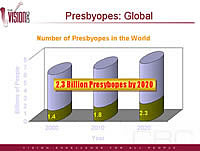 |
| Figure 1 - Presbyopes: Global - click to enlarge |
Presbyopia Market
The number of presbyopes worldwide is rising at a staggering
rate, and is expected to reach 2.3 billion by the year
2020. In the US alone, 42% of the population or 135 million
people will be presbyopic by 2020. These figures are 66%
of the population or 66 million presbyopes in Japan, and
26% of the population or 344 million presbyopes in India
by 2020. |
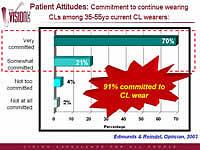 |
| Figure 2 - Patient attitudes - click to enlarge |
What patients want
A survey by Edmunds and Reindel (2003) showed 91% of current
contact lens wearers among 35 to 55 year olds are committed
to continuing with contact lens wear.
However, although 84%
of the US population over 55 years of age require vision
correction, only 5% wear contact lenses, whereas 50% of
the US population between 25 to 34 years of age require
vision correction, and about half wear contact lenses.
The introduction of silicone hydrogels may provide a new boost to this market,
by providing patients the convenience and comfort they want. |
| |
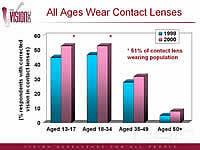 |
| Figure 3 - All ages wear contact lenses - click to
enlarge |
Contact lens options
One of the reasons for the current decline in contact lens use
with age may be the relative complexity of providing satisfactory
vision correction for presbyopia.
Contact lenses for the correction of presbyopia have been available
for many years, and options include:
- Simultaneous vision designs - Each eye is corrected
for distance and near simultaneously. The brain perceives two
images at once from each eye, and therefore to see clearly, the
presbyope learns to automatically process the image which is
in focus for the particular viewing distance (distance or near).
Patients wearing simultaneous vision design contact lenses often
complain of haloes, ghosting and difficulty with night vision.
- Alternating vision designs - These utilize two
distinct zones similar to "bifocal" spectacle lenses, one devoted
to the distance prescription, and one to the near. Contact lenses
must move upwards on the eye during downgaze (a phenomenon called "translation")
while viewing close distances so that the correction zone over
the eye changes from the distance prescription to the near.
Patients wearing alternating vision design contact lenses often
complain that lenses are uncomfortable, as the majority of
translating contact lenses are gas permeable or truncated.
- Monovision - One eye is corrected with the distance
prescription, while the other eye is corrected for near,
and the presbyope automatically selects the in-focus image,
providing relatively normal continuous vision. Depth perception
can be somewhat compromised, however patients usually adapt
quickly and learn to utilize alternate visual cues when judging
distances. Monovision has proven to be the most successful
correction option for presbyopes to date, with a fitting success
rate of approximately 80%.
Silicone Hydrogels While silicone hydrogel lenses are not yet available in specific
presbyopia designs such as bifocals, they are an excellent choice
for monovision. Silicone hydrogel lenses are comfortable to wear,
and offer the added convenience of extended wear, which minimizes
the need to handle the lenses on a regular basis. They are particularly
useful for patients who have difficulty seeing to insert and
remove their lenses and who may find daily handling of contact
lenses problematic.
High Dk lens materials also offer ocular health benefits, and
mean the risk of neovascularisation and corneal oedema with conventional
hydrogel contact lens wear, due to the corneal endothelial pump
losing its efficiency with age, is minimized.
Monovision was the preferred mode of correction compared to
bifocal contact lenses for subjects participating in a one year
clinical trial by du Toit et. al., and was also selected as the
first preference for practitioners fitting presbyopic corrections
(Edmunds and Reindel, 2003)
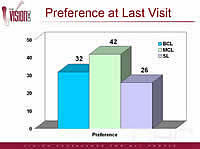 |
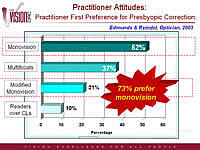 |
| Figure 4 - Preference at last visit - click
to enlarge |
Figure 5 - Practitioner attitudes - click
to enlarge |
Conclusion
By using silicone hydrogel lenses in a monovision mode, practitioners
can provide their presbyopic patients with the most preferred
and successful mode of correction, together with the added advantages
of good ocular health with highly oxygen permeable materials,
and the significant benefits of the convenience of continuous
wear.
In the practice this month details how monovision
silicone hydrogels have rejuvenated Narelle
Hine's contact lens practice for presbyopic hyperopes.
|